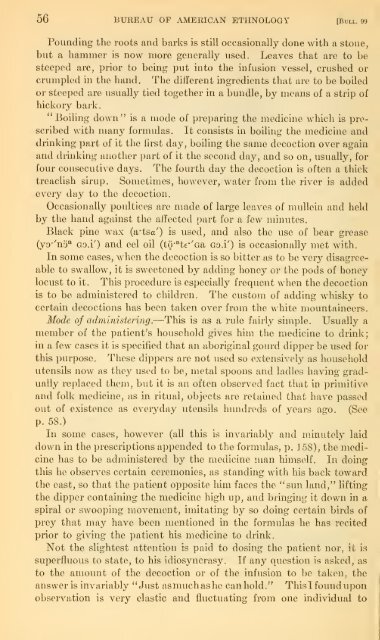Untitled - Smithsonian Institution
Untitled - Smithsonian Institution
Untitled - Smithsonian Institution
You also want an ePaper? Increase the reach of your titles
YUMPU automatically turns print PDFs into web optimized ePapers that Google loves.
56 BUREAU OF AMERICAN ETHNOLOGY [Bull. 90<br />
Pounding the roots and barks is still occasionally done with a stone,<br />
but a hammer is now more generally used. Leaves that are to be<br />
steeped are, prior to being put into the infusion vessel, crushed or<br />
crumpled in the hand. The different ingredients that are to be boiled<br />
or steeped are usually tied together in a bundle, by moans of a strip of<br />
hickory bark.<br />
"Boiling down" is a mode of preparing the medicine which is prescribed<br />
with many formulas. It consists in boiling the medicine and<br />
drinking part of it the first day, boiling the same decoction over again<br />
and drinking another part of it the second day, and so on, usually, for<br />
four consecutive days. The fourth day the decoction is often a thick<br />
treaclish sirup. Sometimes, however, water from the river is added<br />
every day to the decoction.<br />
Occasionally poultices are made of large leaves of mullein and held<br />
by the hand against the affected part for a few minutes.<br />
Black pine wax (a*tsa') is used, and also the use of bear grease<br />
(yo-'no° Go.i') and eel oil (tg-^te-'aa Go.i') is occasionally met with.<br />
In some cases, when the decoction is so bitter as to be very disagreeable<br />
to swallow, it is sweetened by adding honey or the pods of honey<br />
locust to it. This procedure is especially frequent when the decoction<br />
is to be administered to children. The custom of adding whisky to<br />
certain decoctions has boon taken over from the white mountaineers.<br />
Mode oj administering.—This is as a rule fairly simple. Usually a<br />
member of the patient's household gives him the medicine to drink;<br />
in a few cases it is specified that an aboriginal gourd dipper be used for<br />
this purpose. These dippers are not used so extensively as household<br />
utensils now as they used to be, metal spoons and ladles having grad-<br />
ually replaced them, but it is an often observed fact that in primitive<br />
and folk medicine, as in ritual, objects are retained that have passed<br />
out of existence as everyday utensils hundreds of years ago. (See<br />
p. 58.)<br />
In some cases, however (all this is invariably and minutely laid<br />
down in the prescriptions appended to the formulas, }). 158), the medi-<br />
cine has to be administered by the medicine man himself. In doing<br />
this he observes certain ceremonies, as standing with his back toward<br />
the east, so that the patient opposite him faces the "sun land," lifting<br />
the dipper containing the medicine high up, and bringing it down in a<br />
spiral or swooping movement, imitating by so doing certain birds of<br />
prey that may have been mentioned in the formulas he has recited<br />
prior to giving the patient his medicine to drink.<br />
Not the slightest attention is paid to dosing the patient nor, it is<br />
superfluous to state, to his idiosyncrasy. If any question is asked, as<br />
to the amount of the decoction or of the infusion to be taken, the<br />
answer is invariably "Just asmuchashe can hold." This I found upon<br />
observation is very elastic and fluctuating from one individual to

















